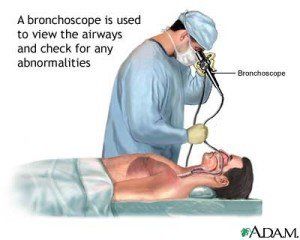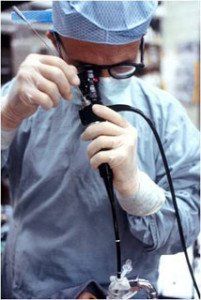Patient Resources
When is Bronchoscopy done?
A bronchoscopy is used to evaluate lung symptoms such as a chronic cough, the coughing of blood or when lung disease or cancer is suspected after xray studies. During a bronchoscopy, doctors are able to see the inside of your airways. If there are areas that are abnormal, a biopsy or lavage (the collection of your secretions) can be done in order to diagnose lung disease or cancer. In addition, a bronchoscopy may also be used for treatment e.g. to temporarily stop bleeding in the airways or in the case of airway narrowing, to insert a stent to open up the airway.
Preparing for a Bronchoscopy
Before performing a bronchoscopy, your specialist will talk to you about the procedure, the risks involved and what he may expect to find. You will be asked to sign a consent form. If you are on any blood-thinning medications, such as aspirin, clopidogrel (Plavix) or warfarin (Coumadin), you may be asked to discontinue these for a period of time before the test. In addition, you will be asked to fast (not eating or drinking) for 4-6 hours before the bronchoscopy.
The Bronchoscopy itself
At the start of the bronchoscopy, you will be given a local anaesthetic to numb your throat and nose, and a medication to make you sleepy. The duration of the bronchoscopy can vary, anywhere from 10 minutes to 1 hour, depending on what the specialist sees during the procedure and what needs to be done, e.g. biopsy. Throughout the procedure, your blood pressure, heart rate and oxygen level will be continuously monitored.
What happens after the Bronchoscopy?
After the bronchoscopy, you will be monitored for 2-4 hours in the recovery area. Your throat may be irritated and you may continue to feel groggy because of the sedatives administered to you. Typically, you are only able to eat and drink after 2-3 hours. You may cough up small amounts of stale blood for a day or two. As the effects of the medications can last for several hours, it is important that you are accompanied by someone who will be able to take you home..
Possible Complications of Bronchoscopy
A bronchoscopy is usually very well-tolerated. Occasionally, the following complications may occur:
- Bleeding or pneumothorax (collapse of the lung due to a collection of air trapped in the cavity between the lung and the chest wall). These complications can occasionally occur, especially after a biopsy.
- Hoarseness
- Infection
- Spasm of the airway, leading to breathlessness
- Heart complications such as an abnormal rhythm or even a heart attack
- Complications related to the sedative medications.
Sign up to receive latest updates
Subscribe to our newsletter
We will get back to you as soon as possible
Please try again later
Our Locations
Suite 07-14, Gleneagles Medical Centre, 6, Napier Road, Singapore 258499.
WhatsApp: +65 9643 3920
Phone: +65 6473 9984
Email:
info@respmed-associates.sg
Suite 15-11, Mount Elizabeth Hospital, 3, Mount Elizabeth, Singapore 228510.
Phone:
+65 6732 5788
Suite 04-33, Mount Elizabeth Novena Specialist Centre, 38, Irrawaddy Road, Singapore 329563.
Phone:
+65 6734 4788
Respiratory Medical Associates. All Rights Reserved. Website Designed by Heroes Of Digital.







